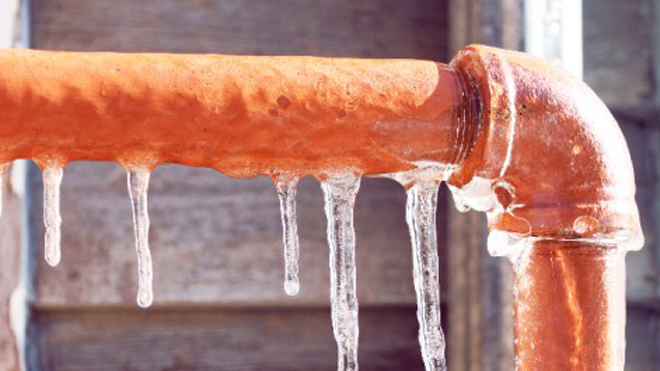Tips to Safeguard Your Pipes from Cold Weather: Expert Tips
Tips to Safeguard Your Pipes from Cold Weather: Expert Tips
Blog Article
The article listed below involving Winter Plumbing Precautions: Preventing Frozen Pipes is truly compelling. You should keep reading.

Winter can damage your pipes, particularly by freezing pipes. Below's how to stop it from happening and what to do if it does.
Introduction
As temperature levels drop, the danger of frozen pipes boosts, possibly resulting in expensive fixings and water damage. Comprehending exactly how to prevent frozen pipes is important for house owners in cool climates.
Avoidance Tips
Insulating at risk pipes
Cover pipes in insulation sleeves or utilize heat tape to safeguard them from freezing temperatures. Concentrate on pipes in unheated or exterior areas of the home.
Heating strategies
Keep interior rooms appropriately heated, especially areas with plumbing. Open cabinet doors to permit cozy air to distribute around pipes under sinks.
How to determine frozen pipes
Look for lowered water circulation from taps, unusual odors or sounds from pipelines, and visible frost on exposed pipelines.
Long-Term Solutions
Structural adjustments
Take into consideration rerouting pipes far from outside walls or unheated locations. Add added insulation to attics, cellars, and crawl spaces.
Updating insulation
Invest in high-quality insulation for pipes, attic rooms, and walls. Appropriate insulation assists maintain constant temperature levels and minimizes the risk of icy pipes.
Protecting Exterior Plumbing
Garden hose pipes and exterior faucets
Detach and drain garden tubes prior to winter season. Mount frost-proof faucets or cover outdoor faucets with insulated caps.
Comprehending Icy Pipelines
What causes pipes to ice up?
Pipelines freeze when subjected to temperatures listed below 32 ° F (0 ° C) for prolonged periods. As water inside the pipes freezes, it expands, putting pressure on the pipeline walls and potentially creating them to break.
Dangers and damages
Frozen pipes can lead to supply of water disruptions, home damage, and costly fixings. Ruptured pipelines can flooding homes and trigger substantial structural damage.
Indicators of Frozen Pipeline
Determining icy pipelines early can stop them from breaking.
What to Do If Your Pipelines Freeze
Immediate activities to take
If you suspect frozen pipes, keep taps open up to relieve pressure as the ice thaws. Make use of a hairdryer or towels taken in warm water to thaw pipelines gradually.
Conclusion
Stopping frozen pipes calls for aggressive procedures and quick reactions. By understanding the causes, indicators, and preventive measures, homeowners can safeguard their plumbing during winter.
5 Ways to Prevent Frozen Pipes
Drain Outdoor Faucets and Disconnect Hoses
First, close the shut-off valve that controls the flow of water in the pipe to your outdoor faucet. Then, head outside to disconnect and drain your hose and open the outdoor faucet to allow the water to completely drain out of the line. Turn off the faucet when done. Finally, head back to the shut-off valve and drain the remaining water inside the pipe into a bucket or container. Additionally, if you have a home irrigation system, you should consider hiring an expert to clear the system of water each year.
Insulate Pipes
One of the best and most cost-effective methods for preventing frozen water pipes is to wrap your pipes with insulation. This is especially important for areas in your home that aren’t exposed to heat, such as an attic. We suggest using foam sleeves, which can typically be found at your local hardware store.
Keep Heat Running at 65
Your pipes are located inside your walls, and the temperature there is much colder than the rest of the house. To prevent your pipes from freezing, The Insurance Information Institute suggests that you keep your home heated to at least 65 degrees, even when traveling. You may want to invest in smart devices that can keep an eye on the temperature in your home while you’re away.
Leave Water Dripping
Moving water — even a small trickle — can prevent ice from forming inside your pipes. When freezing temps are imminent, start a drip of water from all faucets that serve exposed pipes. Leaving a few faucets running will also help relieve pressure inside the pipes and help prevent a rupture if the water inside freezes.
Open Cupboard Doors
Warm your kitchen and bathroom pipes by opening cupboards and vanities. You should also leave your interior doors ajar to help warm air circulate evenly throughout your home.

As a devoted person who reads on Winter Plumbing Precautions: Preventing Frozen Pipes, I was thinking sharing that section was essential. Enjoyed our posting? Please share it. Let somebody else find it. Many thanks for your time invested reading it.
This Resource Report this page